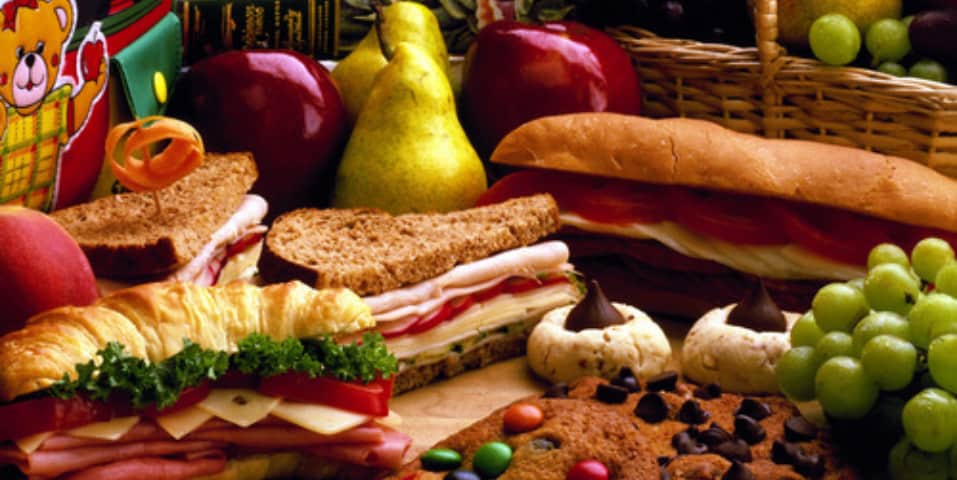Myths and misinformation abound in the cooking world. From old wives tales to supposed anecdotes, much of what we have been taught is just downright wrong. Many myths just lead to added steps and time to your food preparation, and in the long run, an inferior product.
Although most of this information can be found all over the internet, it bears repeating as these myths just don’t seem to go away. Not only do I hear this misinformation repeated back to me time and again from novices and home cooks, but many of these myths are still held as gospel by many professional chefs and are often perpetuated, unknowingly by television chefs who fail to question the validity of these long- held beliefs.
Myth #10: Bread goes stale because it “dries” out.
It’s happened to all of us; you make a sandwich, forget to close the bread bag tightly, and the next day it’s stale. Since the bread has become hard it seems reasonable to believe that it has “dried out.” In fact, it is just the opposite of what common sense would seem to dictate; the bread has suffered from too much humidity. When bread or any baked product is exposed to too much moisture, the starches crystallize, leaving the bread hard. This is why it often seems to go stale faster in summertime and why storing baked goods in the fridge is not a good idea.
Myth #9: Eating undercooked pork will make you sick or give you worms.
Here’s a myth that has a basis in reality. Years ago, before modern farming practices, trichinosis (a parasitic worm) was a legitimate concern in pork. Like many foodborne illnesses, the key to prevention is to cook your meat to a minimum of 165°F. For many cuts of pork, this resulted in dry, tough meat. Today’s pigs are much leaner, because of breeding and farming practices, which means that overcooking pork often leads to meats that are so dry and tough they are almost inedible and require copious amounts of gravy just to get them down. Luckily, many of these same farming practices have reduced the risk of trichinosis to almost zero. Most chefs are on board with this change and many restaurants will now serve pork chops, and the like, somewhere in the medium to medium-well range, ensuring that the meat still retains its moisture. Unfortunately, those who learned to cook from their mothers and grandmothers, are still making the mistake of cooking pork well past the point of being safe and the resultant meat comes out dry and tough.
Myth #8: Putting oil in your pasta cooking water will keep it from sticking.
While talking about this myth I might as well cover another myth, which is that you should rinse your pasta to keep it from sticking. While this myth is actually true, to an extent, this is not something that you really want to do. When you remove pasta from its cooking water the pasta is still covered in a layer of starch. This is why pasta sticks together. This same starch helps your sauce stick to your pasta. By rinsing, or oiling your pasta, you make it slippery and the sauce has a hard time really holding on to it, leaving much of your sauce to pool on your plate instead of enveloping your pasta.
Myth #7: Washing mushrooms will make them waterlogged.
Another myth with some basis in reality, but it’s not what you think. While older, dried out mushrooms might absorb water to replace their lost moisture, most mushrooms that you purchase are still relatively fresh and have retained most of their moisture, thus will not readily absorb more moisture unless left to soak in water for a considerable length of time. So if you don’t want to waste your time brushing the dirt off of each individual mushroom, then go ahead and give them a quick rinse. But be sure to give them a quick pat with a towel to ensure that you are not introducing excess moisture to the pan from the water still clinging to the outside of the mushrooms. Also remember that mushrooms are primarily made up of water so no matter what, once you start to cook them, they will throw off a considerable amount of moisture. That said, it is best to sauté them in small batches so that the moisture that does develop is driven off quickly and they do not steam or boil in their own juices.
Myth #6: Salt is salt.
Salt comes in all sorts of shapes, sizes, and flavors, but not all of them are completely interchangeable. If your recipe calls for kosher salt and all you have is table salt, chances are you can use either one, but be aware that if you use table salt you will probably have to cut back your measurement since it has a much finer grain that most kosher salts, resulting in a volume measurement that weighs more than a volume measurement of kosher salt, which in turn will make your food more salty. When it comes to canning, fermenting and preserving, you should avoid using table salt, which often contains iodine and anti-caking agents. Not only can these additives result in canned food with “off” flavors, iodine is a mild sanitizer and, in the case of fermentation, can retard the growth of bacteria that you are trying to grow in the process. Finally, when it comes to sea salts, it is best used to finish dishes rather than use for cooking. Sea salts are revered for their flavors because of the various other minerals they contain, which makes sea salts from different regions, unique. But because of those varying qualities I don’t like to add them to dishes because I can’t guarantee the end result. With some salts, their subtle qualities will be lost in the dish and with others they might contribute strange flavors in the amounts used. It is best to stick with a more generic kosher salt while cooking and reserve sea salts for the final flourish before serving, which allows both the salt and the food to shine.
Myth #5: Stewed or braised meat stays more moist than roasted meats.
In general, the moistness of meat is not a result of the way in which it is cooked but in how hot it is cooked and the internal temperature of the meat. To understand this, think of meat as a sponge filled with water. The more you squeeze the sponge, the more water you drive out of it. As the meat heats, and cooks, the muscle fibers start to contract. That contraction is just like squeezing the sponge. As those fibers contract they force moisture out of the meat. Because meat cooks from the outside, in, the moisture is first driven towards the center of the meat as the outer muscle fibers cook first, but eventually, as the interior of the meat gets hotter, the moisture will be driven out completely. This is why it is always a good idea to let meat rest, at room temperature, for a period of time after cooking. Those outer muscle strands that had contracted during the cooking process will start to relax allowing all that moisture, which had been driven into the center, to disperse throughout the meat again. While braising and stewing can be safety nets by buffering the meat from harsh heat you can still end up with dry meat if you let your braising liquid get too hot. This is why many recipes for stews and braises warn against letting your liquid come up to a boil once you’ve added your meat, because no matter how long you keep your meat in the liquid, it will not re-absorb moisture once it has all be driven out of it.
Myth #4: Marinating meat will make it more tender.
Fact, acids will act upon meat, effectively cooking the proteins, making it more tender. So why is this a myth? Very simply, because marinades do not penetrate very far into the meat. Not enough to tenderize anything but the most paper thin of cuts. It is true that dairy- based marinades (like yogurt or buttermilk) will penetrate further into meat but even then they don’t penetrate very far. And forget about just leaving it in the marinade longer. Do that and you risk turning the outside of your meat mushy while the rest remains tough. Your best bet for tenderizing a tough piece of meat is by breaking up the muscle fibers, either through pounding or cutting up those fibers mechanically or through your cooking process, which means cooking slow and low to allow the heat time to work the tough fibers.
Myth #3: The recipe came from a cookbook, so it must be accurate.
While this one tends to trip up beginning cooks the most, it also catches a lot of experienced cooks. Trust me, as someone who has reviewed many cookbooks and owns hundreds of them, there are a lot of mistakes in recipes: from missing ingredients to wrong measurements. Before you start cooking from a new recipe, make sure you have read it all the way to the end and make sure you understand it and that all the ingredients and instructions make sense. Also, consider cooking times to be guidelines, not hard and fast rules. While many cookbook authors try very hard to get cooking times correct, everyone’s stoves and ovens are different. I usually start checking on an item when it has gone through about 75% of the stated cooking time. Remember, you can always cook it a little more. There’s not much to be done for overcooked food. This is doubly important when it comes to recipes from the internet. At least, with cookbooks, you can expect some form of recipe testing and editing, but when it comes to the internet you can’t expect anything to be accurate, even if it comes from a “trusted” source.
Myth #2: Alcohol completely evaporates out of food when you cook it.
This myth still runs rampant in kitchens all around the world, and chefs are just as likely to fall into this trap as the home cook. The general wisdom states that you can quickly evaporate or burn off alcohol if you bring your sauce to a boil. Unfortunately, scientists tell a different story, stating that the alcohol you just flambéed can retain up to 75 percent of its alcohol and a sauce that has been simmered for 15 minutes can still contain up to 40 percent of its alcohol. It takes about two and a half to three hours to burn off all but about five percent of the original alcohol. Granted, the overall amount of alcohol in most dishes is not a significant amount when you look at the volume of alcohol added to the whole volume of the dish, but still, this could be of concern to recovering alcoholics or those who abstain from alcohol for health or religious reasons.
Myth #1: Searing meat seals in the juices.
So much as been written to try and dispel this myth, but I still hear it all the time. Searing meat does not seal in the juices. In fact, if anything, it tends to dry out the meat, although it is only a small portion right on the surface so it does not dramatically reduce the moisture content overall, but the fact remains: searing is more apt to slightly dry out a piece of meat rather than seal in its juices. So why sear meat anyway? Very simply, because it makes it taste great. When we sear meat we start a process called the “maillard reaction” in which sugars combine with proteins and amino acids to form other compounds resulting in that deep, rich flavor that we associate with well- browned meats. Not only are these flavor compounds created, but searing the meat, through both the maillard reaction the drying of the outer layer of muscle fibers, also creates a wonderful crust that contrasts to the soft interior, adding another layer of complexity. So, even though searing meat does not “seal” in the juices, there are plenty of reasons that you should still give your meat a good sear.
















